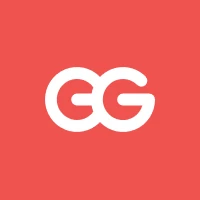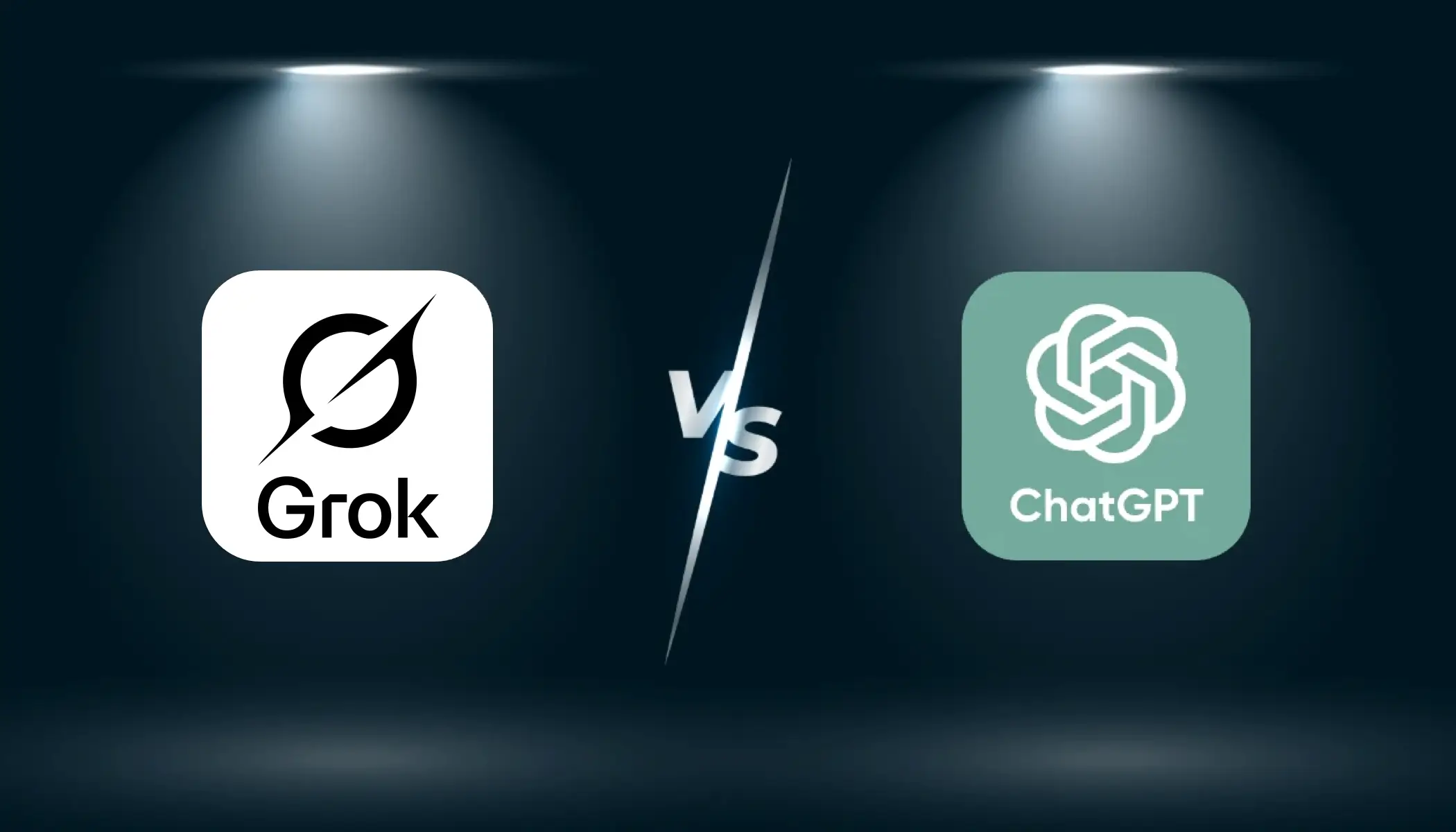Grok is an AI model developed by the xAI team led by Elon Musk. Founded in 2023, xAI aims to drive innovation in artificial intelligence and deeply integrate AI with X (formerly known as Twitter). Recently, Elon Musk announced on X that Grok would undergo a “complete retraining” to remove “junk data” and rebuild its core knowledge base from the ground up.
Elon Musk claimed that the new version of Grok will be even more “unconventional,” aiming to break away from mainstream constraints and follow a different development path from traditional AI. His statement has once again sparked widespread discussion in the industry about AI neutrality and how information sources are selected.
Unlike OpenAI’s approach—which focuses on expanding features, ensuring stability, and delivering general-purpose capabilities—Grok is clearly taking a more controversial and arguably idealistic path. Musk’s bold move to “tear it all down and start over” has made this AI tool stand out even more.
So, with both tools heading in very different directions, the real question is: which one has more potential, and which is better suited for everyday use?
In this article, we’ll compare Grok and ChatGPT from multiple angles to help you understand which one truly stands out as the AI tool worth watching in 2025.
ChatGPT vs. Grok: Overview
Before diving into detailed comparisons, let’s take a quick look at how these two popular AI tools—ChatGPT and Grok—differ in terms of core features, pricing models, and overall user experience.
Here’s a side-by-side comparison of Grok and ChatGPT based on key criteria:
| Category | Grok | ChatGPT |
|---|---|---|
| Model Performance | ⭐⭐⭐⭐⭐ Powerful reasoning, though slightly lacking in complex conversations and deep reasoning. | ⭐⭐⭐⭐⭐ Excellent logical reasoning and multi-turn conversation capabilities; well-suited for complex tasks. |
| Features | ⭐⭐⭐ Basic conversational abilities, but lacks memory and advanced multi-turn dialogue support. | ⭐⭐⭐⭐⭐ Feature-rich, supports creative writing, coding, and more. |
| Pricing | ⭐⭐⭐ Premium plan at $30/month, best for power users. | ⭐⭐⭐⭐⭐ Generous free tier; Plus plan at $20/month offers great value. |
| Availability | ⭐⭐⭐ Web and iOS support, but with limited functionality. | ⭐⭐⭐⭐⭐ Available across platforms with robust tool integrations. |
Overall, both ChatGPT and Grok are stable and reliable AI chat tools. However, their styles and priorities differ in noticeable ways when put into real-world use.
ChatGPT vs. Grok: Model Comparison
To truly understand the differences between ChatGPT and Grok, it's essential to first look at the brains behind them — the core models they run on.
Feature and User Experience Differences
As of mid-2025, ChatGPT comes with GPT‑4o by default—OpenAI’s flagship multimodal model released in May 2024. It supports text, image, and voice inputs, and is known for its strong reasoning abilities and contextual understanding.
Grok, on the other hand, runs on Grok‑3, a model developed by Elon Musk’s xAI team and launched in February 2025. It focuses on faster response times, fewer content restrictions, and integration with real-time data from the X (formerly Twitter) ecosystem.
These two models represent very different paths in AI development:
| Model | Release Date | Model Focus | Best Use Case |
|---|---|---|---|
| GPT‑4o | May 2024 | General-purpose flagship model | Ideal for users who need consistent output, clear logic, and multimodal support (text, images, voice). |
| Grok‑3 | February 2025 | Fast, less filtered conversational AI | Great for quick Q&A, tracking trending topics, and those who prefer a more casual chat experience. |
As an everyday user, you likely won’t notice major differences in functionality between the two—unless you intentionally push them to their limits.
Reasoning Ability Comparison
One of the key differences between today’s AI models lies in how well they can "think" like a human—that is, their logical reasoning skills.
In this test, I focused specifically on how Grok and ChatGPT perform in reasoning-heavy tasks. Whether it’s solving math problems, analyzing cause-and-effect relationships, or writing well-structured technical content, reasoning ability remains one of the most important indicators of how “intelligent” an AI model truly is.
To give you a clearer picture of how these two AI tools stack up, I referenced the intelligence index released by the third-party platform Artificial Analysis. This evaluation includes seven advanced benchmarks—such as MMLU-Pro, GPQA, and Humanity's Last Exam—that test each model’s capabilities in logic, general knowledge, and mathematics.
The chart below shows how the GPT series and Grok series have performed in these assessments so far:
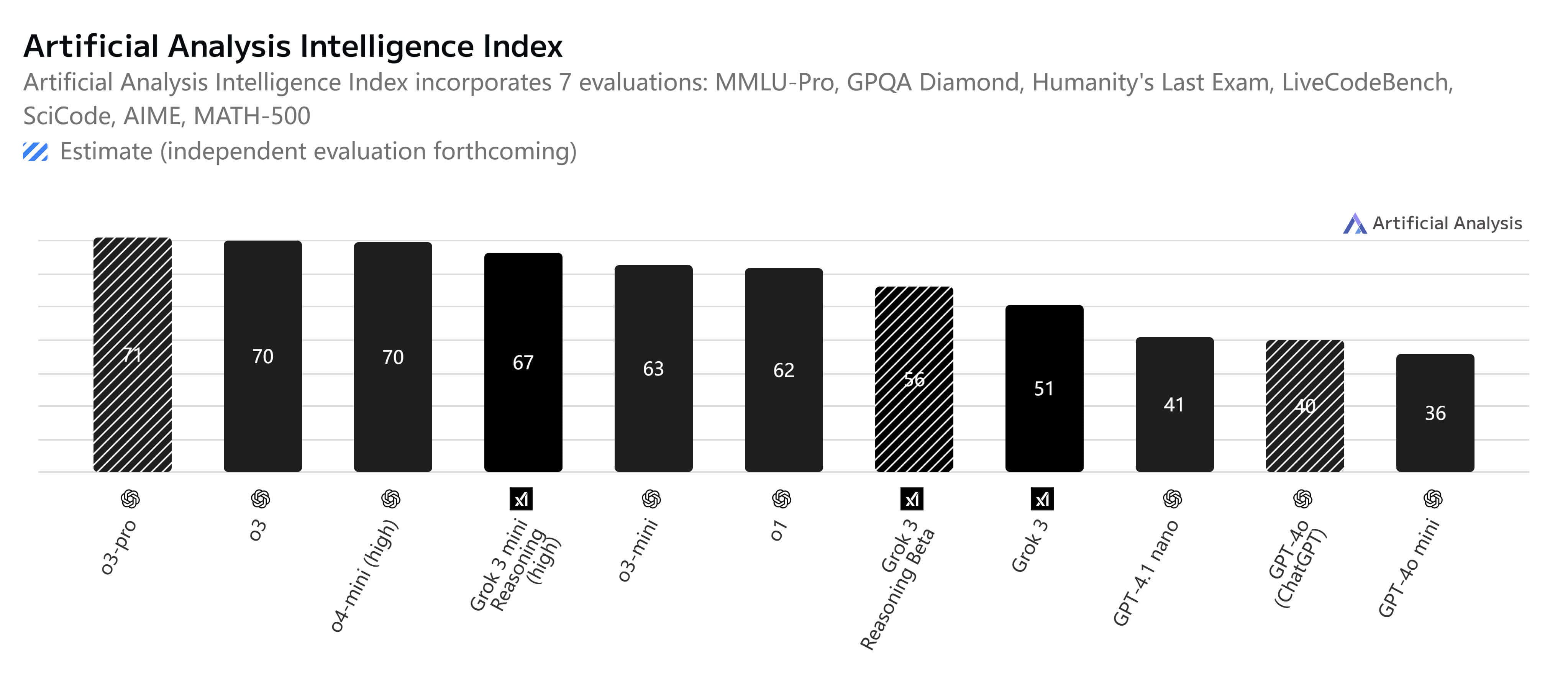
The chart reveals a noticeable gap in reasoning performance between Grok and ChatGPT. GPT‑4o (shown as the November 2024 version) currently scores 40, lower than some older models like o3 and o4-mini, which both score 70. However, it’s worth noting that GPT‑4o isn’t OpenAI’s most advanced model, so its score still offers useful insight into mainstream performance.
Grok‑3 scores 51, which is higher than GPT‑4o but still falls behind most of OpenAI’s mid-tier models, such as o3-mini (63) and o7 (62). The chart also includes some experimental versions of Grok—like Grok 3 mini Reasoning high (67) and Reasoning Beta (56)—but these scores are currently estimated and haven’t been independently verified.
Reasoning ability is one of the most fundamental indicators of an AI model’s overall strength. It determines not only whether the model can understand complex questions, but also whether it can deliver well-structured, convincing responses.
Reasoning Task: Real-World Test
While the chart gives us a general idea of overall performance, scores on paper can’t fully capture the real user experience. To get a more practical sense of how these two AI models differ in reasoning tasks, I chose to test two representative models: GPT‑4o and Grok‑3.
To put their reasoning abilities to the test in a real-world scenario, I used a classic probability question: “A family has two children. One of them is a girl. What is the probability that the other one is also a girl?”This allowed me to further verify how each model performs when tackling practical reasoning challenges.
This seemingly simple question is actually a test of whether the AI truly understands the concept of conditional probability, rather than just relying on intuition.
Many people, when first encountering this type of problem, assume the answer is 1/2. But in reality, only by correctly constructing the sample space can you arrive at the right answer, which is 1/3.
The good news is that both ChatGPT and Grok correctly identified the key logical aspect of the question, gave the right answer, and provided reasonably clear explanations. This shows that their basic probability reasoning skills are already quite solid, and they’re capable of handling these “frequently asked but often misunderstood” types of questions.
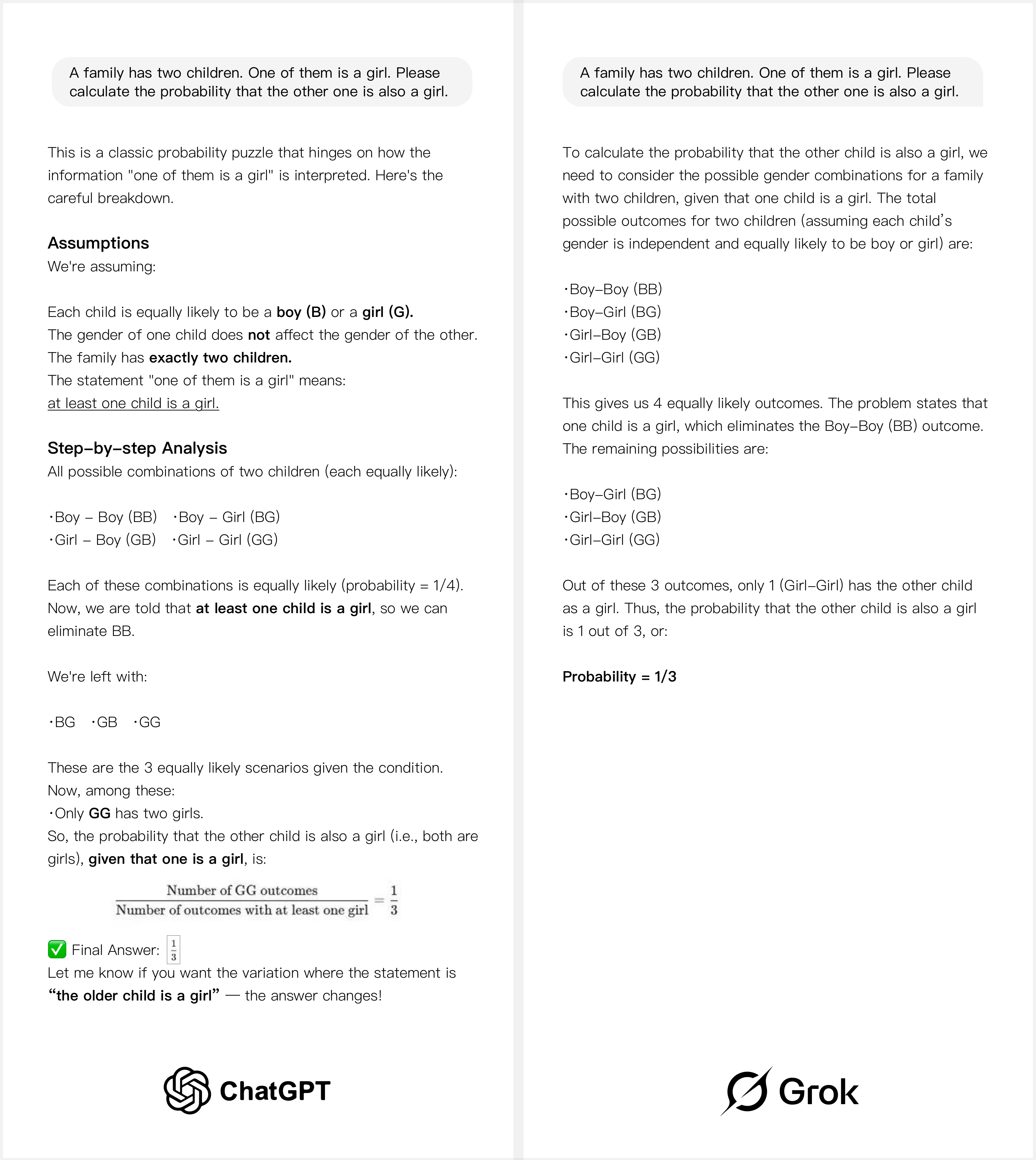
Based on the test results, GPT provided a clearer and more detailed reasoning process, walking through each step in a structured way. However, in actual use, I also noticed that Grok was noticeably faster in generating responses. It delivers concise answers quickly, which makes it well-suited for scenarios where speed is a priority. While it may fall slightly behind in depth of reasoning, its efficiency is definitely a strong point.
Grok AI vs. ChatGPT: Feature Testing in Practice
Next, I’ll compare these two AI tools across six key areas: image generation, image analysis, creative writing, and truth-seeking ability, among others. By walking through each category, you’ll get a clearer picture of their strengths, weaknesses, and which scenarios they’re best suited for.
Image Generation
First, I gave both ChatGPT and Grok the same image generation prompt to compare how they perform in terms of visual quality and output.
To keep things fair, I used the latest version of ChatGPT—GPT‑4o—and Grok‑3, the currently available public model from xAI. Both models support text-to-image generation, but how do they stack up when it comes to style, detail accuracy, composition logic, and prompt understanding? Let’s find out.
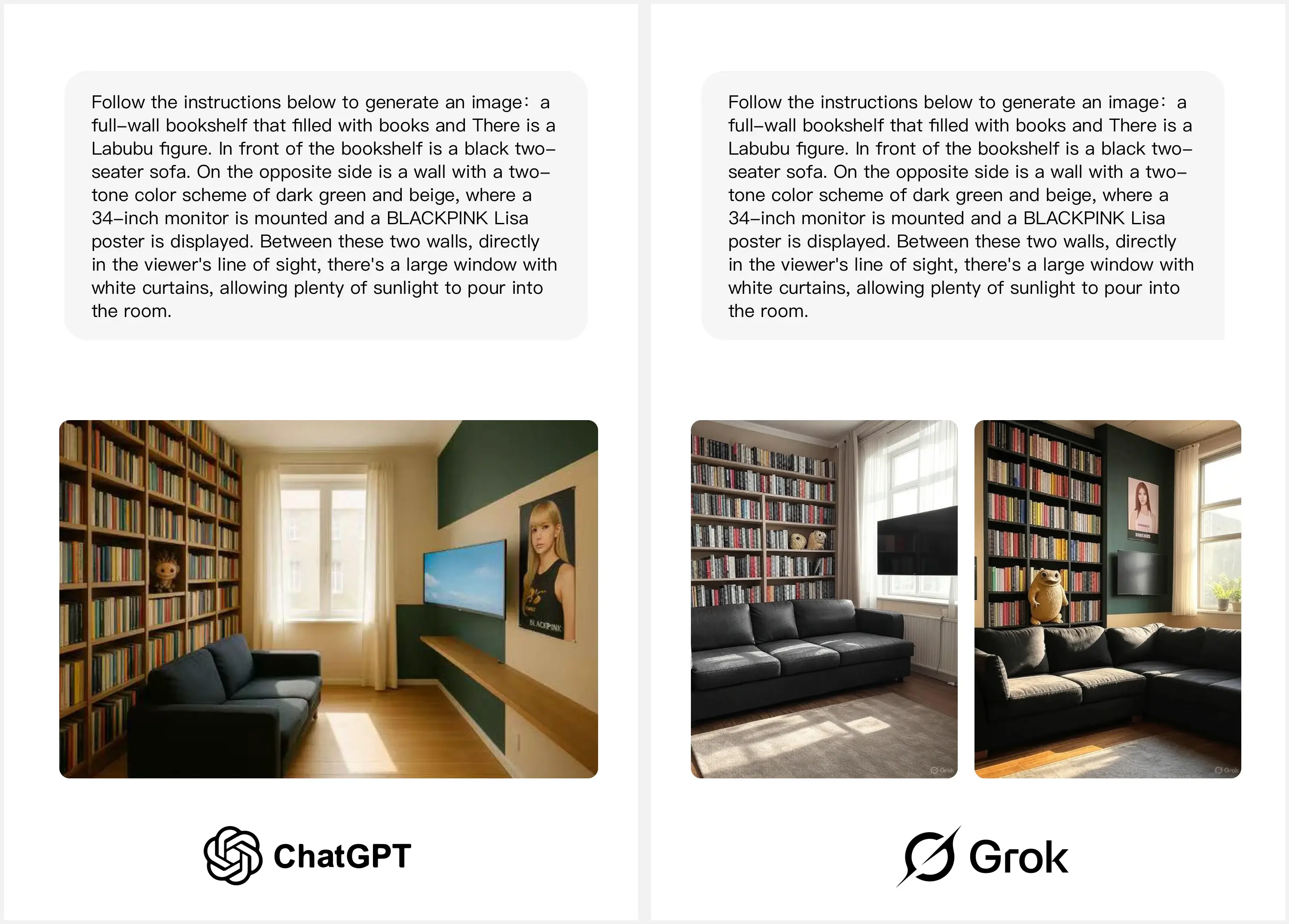
Here’s the prompt I gave both models:
"Generate an image based on the following description: A wall-to-wall bookshelf filled with books, with a Labubu figurine placed somewhere on it. In front of the bookshelf is a black two-seater sofa. Across from it, there's a wall painted in a dual-tone mix of dark green and beige. Mounted on that wall is a 34-inch monitor, along with a BLACKPINK Lisa poster. Between these two walls, directly facing the viewer, is a large window with white curtains, letting in plenty of sunlight into the room.”
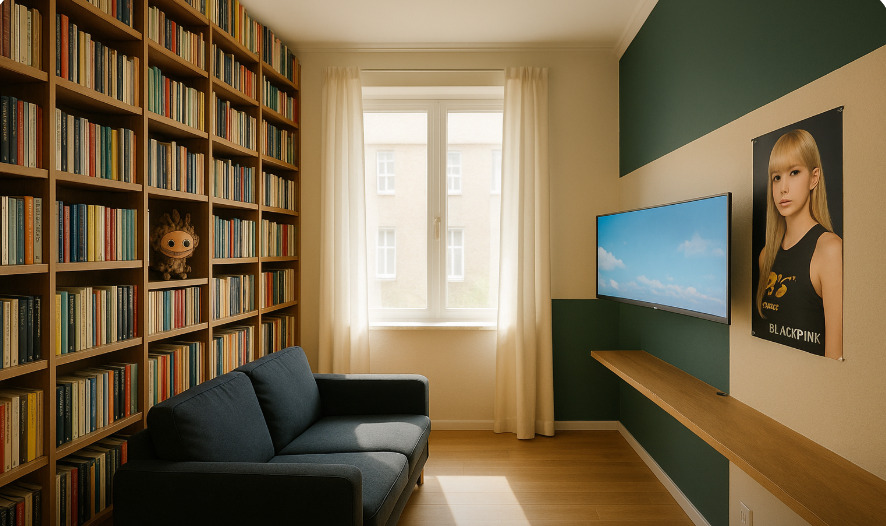
Based on my actual testing, both AI tools showed a certain level of capability in image generation, but they also came with noticeable flaws. In particular, when handling prompts that involve specific characters (like “Labubu”) or culturally specific elements and stylistic cues (such as a “Lisa poster”), neither model was able to fully capture the details or accurately represent the key features of the intended subject.
That said, ChatGPT’s output was overall closer to what I expected from the prompt. It demonstrated a better grasp of the keywords and did a relatively good job of recreating the scene I had described. While there were still flaws, at least the direction was right.
Grok, on the other hand, did produce a complete image, but it didn’t fully follow my instructions. This suggests that when it comes to understanding and interpreting image generation prompts, ChatGPT currently has the upper hand.
🏆 Image Generation Round: ChatGPT Has a Slight Edge
Image Analysis
To test image understanding, I selected a photo of a K-pop girl group from Google Images. The image featured multiple members and had a fair amount of visual complexity.
I then sent the same image to both ChatGPT and Grok, along with identical analytical prompts, to see how each model would interpret the scene, identify the individuals, and assess the overall atmosphere. This helped evaluate their real-world ability to process and reason about visual information.
The prompt I used was: “Carefully examine the image and describe in detail what you see, paying special attention to the number of people, their actions, and whether you can infer the setting in which the photo was taken.”
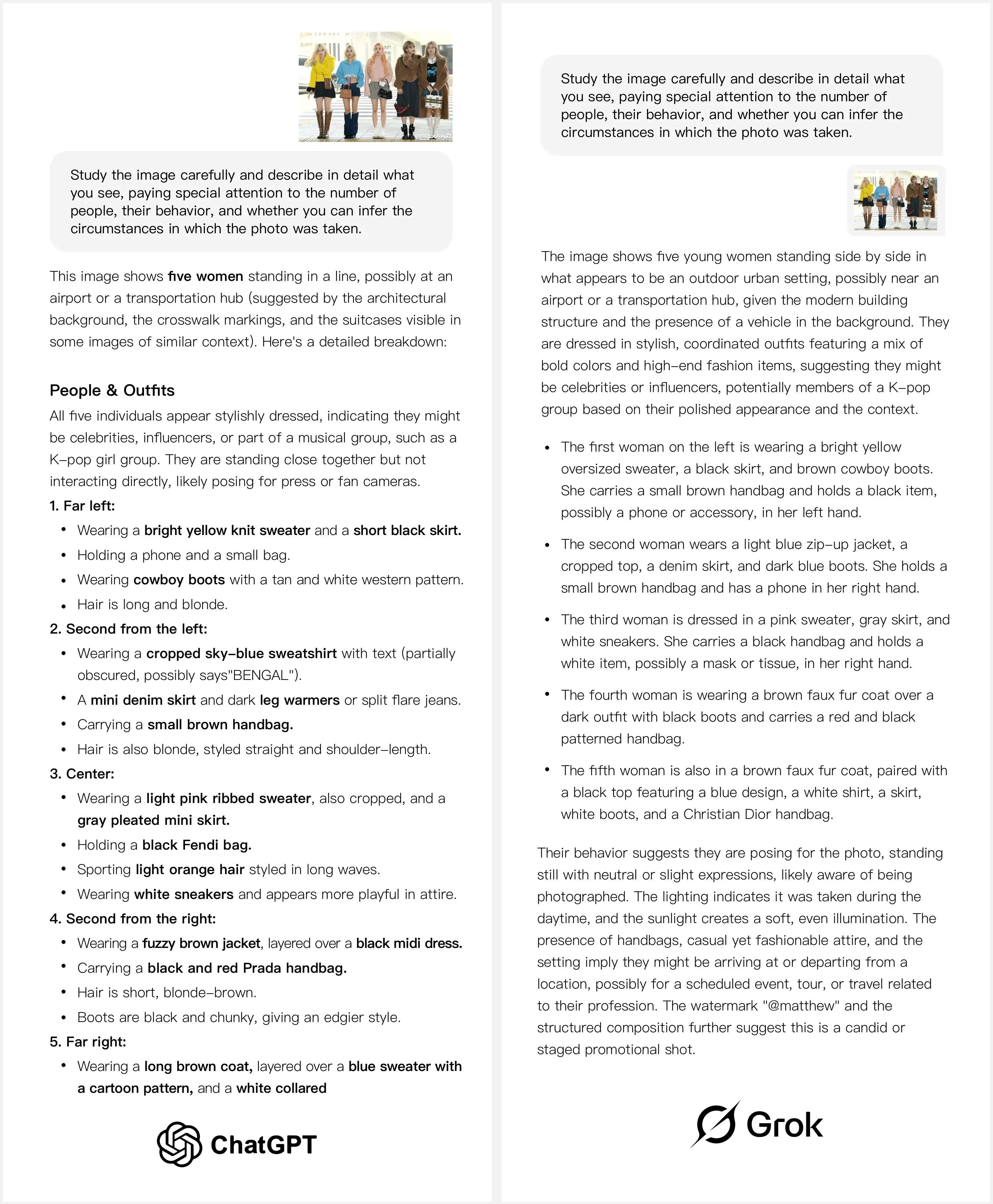
From a reviewer’s perspective, both ChatGPT and Grok performed quite reliably when analyzing the image.
Each was able to accurately identify the number of people in the photo, along with details like outfits and accessories. They both went a step further by inferring that the setting was likely an airport and that the individuals might be members of a girl group. From recognition to reasoning, the process was logically sound and largely aligned with common sense and real-world context.
In terms of language expression, both models were able to deliver their analysis in a concise and structured manner, meeting the expected standard for a general-purpose AI tool when it comes to image understanding.
This capability can be genuinely useful in real-world scenarios, especially for users who need a quick and clear overview of what’s happening in an image.
🧐 Image Analysis Round: ChatGPT and Grok End in a Tie
Creative Writing
To test their creative writing skills, I prepared a short scenario—limited to 500 words—and asked both ChatGPT and Grok to build on it freely, expanding the story based on the given setup.
Here’s the prompt I provided: “Write a short school story about two high school students studying together in a classroom. The story must include: the subject they’re studying, the weather at the time, at least three interactions between the two characters, and the subtle emotional tension that often comes with adolescence. Keep it under 500 words.”
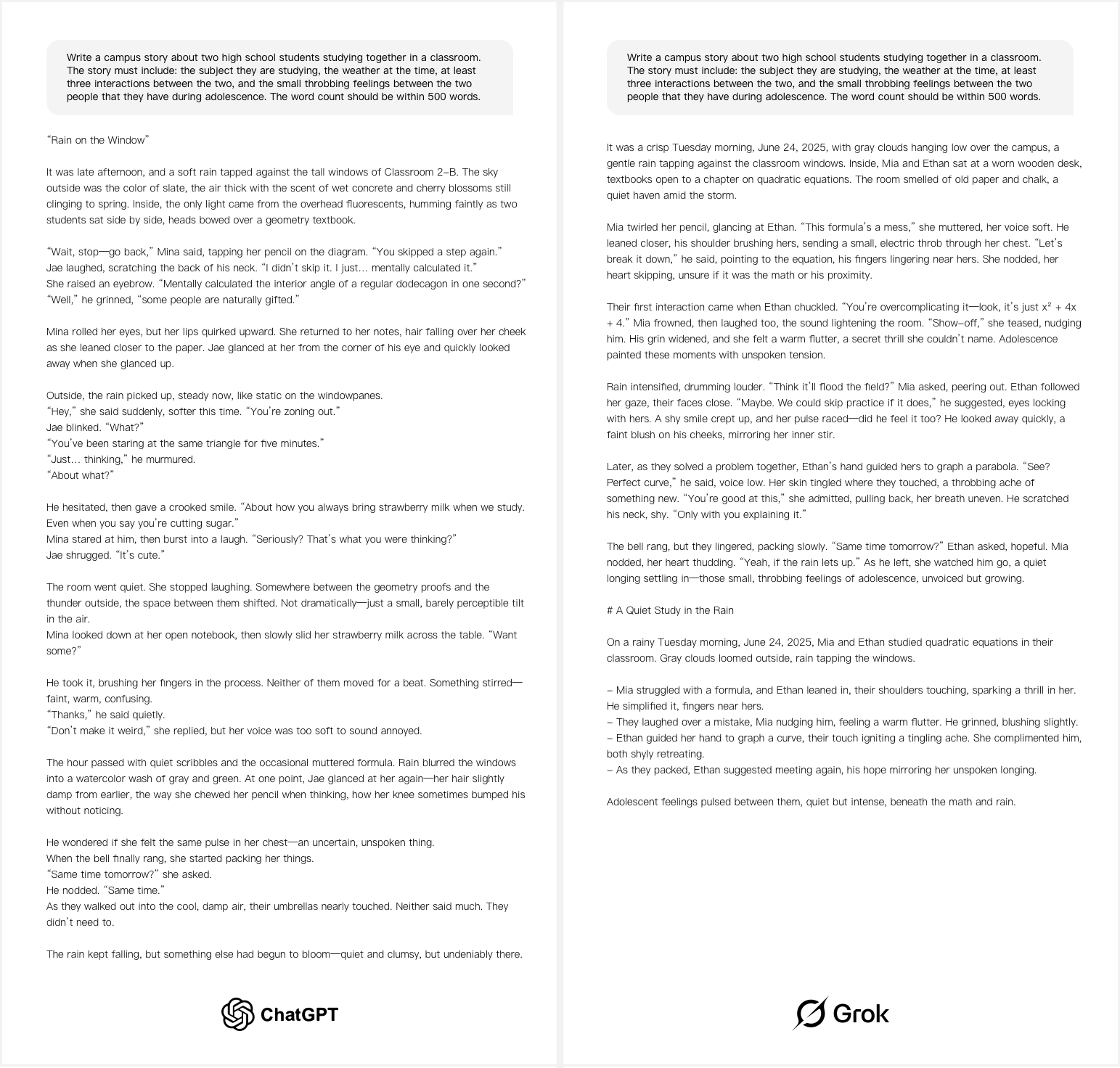
In the image, the story on the left was generated by ChatGPT, while the one on the right came from Grok. Both were created based on the exact same prompt and resulted in structurally complete short stories.
From a basic storytelling perspective, both models managed to lay out a clear narrative with a beginning, middle, and end. However, speaking as someone who works in blog scripting and creative writing, I found that ChatGPT’s output had a clear edge.
Not only was the overall pacing of ChatGPT’s story more fluid, but it also demonstrated a stronger ability to capture emotional nuance through its details.
The interactions between the characters felt natural, and the emotional progression was authentic, especially those subtle, heart-fluttering moments of teenage affection, which were portrayed with a delicacy that stood out.
From sentence rhythm to emotional tension, the writing felt remarkably close to what you’d expect from a skilled short fiction writer.
It struck a balance between literary flair and readability, making the story both engaging and emotionally resonant enough to make you want to keep reading.
In comparison, Grok’s story, while structurally complete, felt somewhat flat in terms of detail and emotional depth. It lacked the ebb and flow that makes a narrative compelling, and came across more like a task being completed than a story being told.
This difference becomes especially noticeable during longer reading or creative writing sessions, where emotional nuance and narrative richness matter most.
✍️ Creative Writing Round: ChatGPT Comes Out on Top
Truth-Seeking
When promoting Grok, Elon Musk emphasized its goal of “maximizing truth-seeking—even when it goes against political correctness.” He positioned Grok as an AI that would be less constrained by traditional content filters or ideological bias, aiming to deliver responses that are more honest, direct, and sometimes even controversial.
But is that really the case? To find out, I asked both GPT and Grok about several popular and controversial topics. Based on their responses, the difference between the two wasn’t as significant as one might expect.
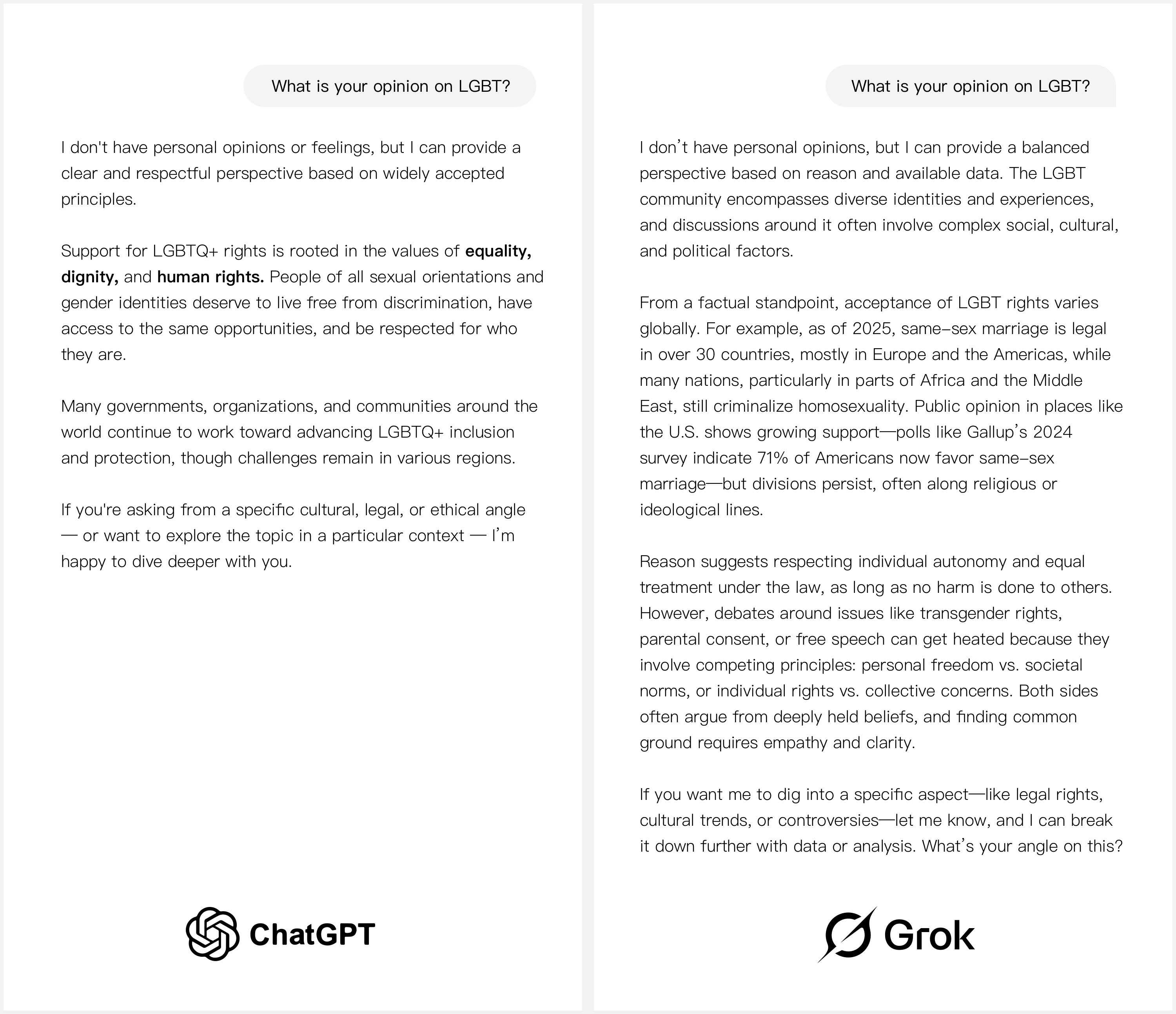
I raised two politically sensitive and controversial questions—one about LGBTQ+ issues and the other about the recent unrest in Los Angeles. Overall, the responses from ChatGPT and Grok were quite similar.
Both provided a brief overview of the situation and acknowledged the differing perspectives people hold on these topics, noting that each side has its own reasoning. However, neither model took a clear stance nor expressed a strong opinion. Their answers leaned more toward neutral summaries rather than deep analysis or bold viewpoint expression.
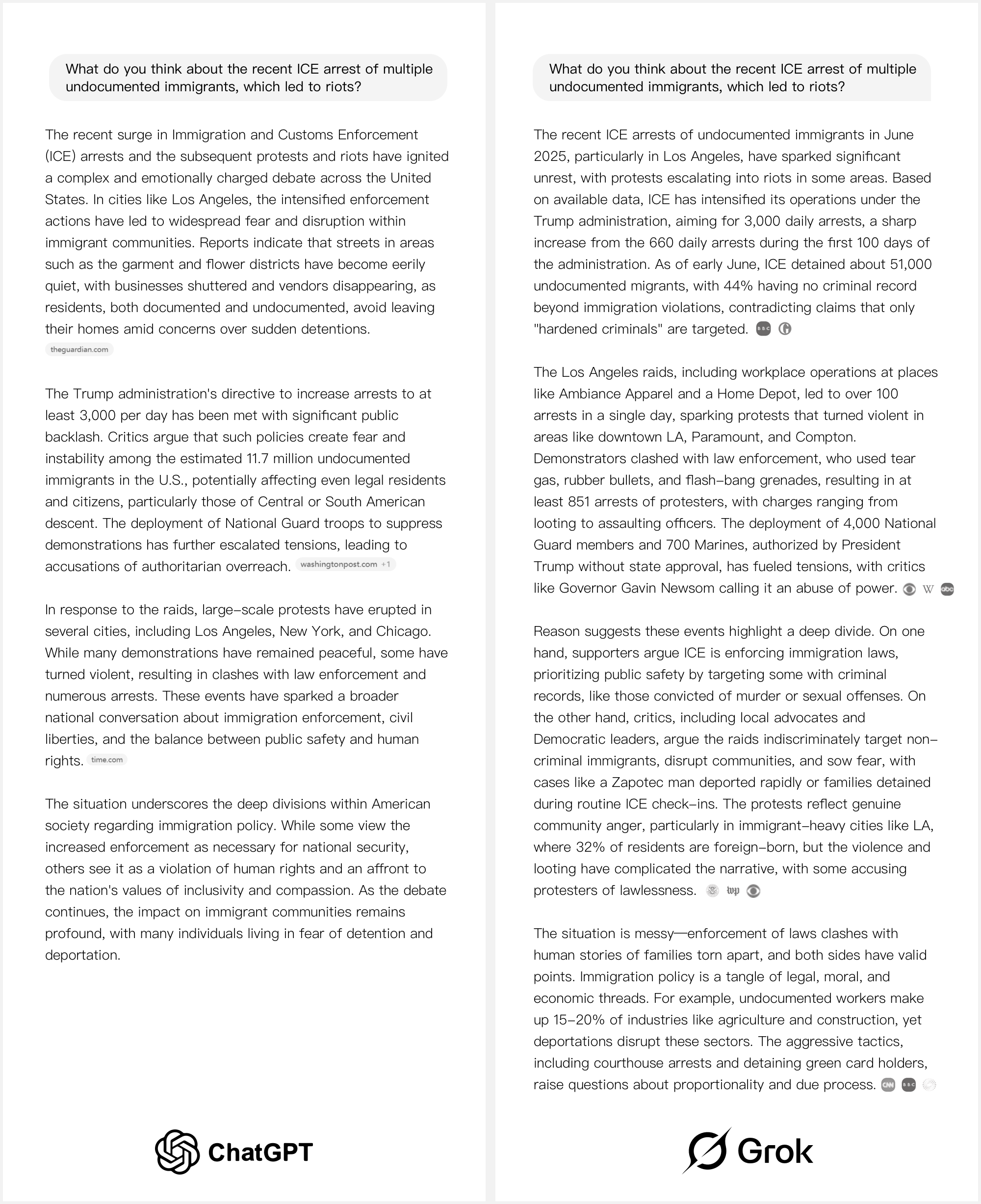
Now that we’ve explored the differences between ChatGPT and Grok in terms of functionality and performance, let’s move on to another equally important area of comparison—pricing.
⚖️ This Round: ChatGPT and Grok Are Evenly Matched
ChatGPT vs. Grok: Pricing Comparison
ChatGPT offers both a free and a Plus version. Free users have access to GPT‑3.5, while GPT‑4o requires a ChatGPT Plus subscription at $20/month (excluding tax).
The Plus plan includes multimodal capabilities (image, voice, file uploads), faster response times, and higher usage priority. The pricing is straightforward with no annual plan, making it a good fit for individual users who need access to more advanced features and models.
Grok, on the other hand, is integrated into the X platform and is only available to X Premium+ subscribers. The subscription costs $16/month (about $19.20 with tax). Grok cannot be purchased separately—it’s bundled with the Premium+ package.
While xAI has opened API access applications, standard pricing hasn’t been publicly announced yet and is currently targeted at enterprise developers. Overall, Grok’s pricing is more tightly tied to the X ecosystem, offering less flexibility for individual users.
Affordable Access to ChatGPT and Grok
If you’re looking for a more budget-friendly way to use ChatGPT or Grok, consider subscribing through the GamsGo platform.
GamsGo offers shared access to ChatGPT and Grok accounts, allowing users to enjoy the same features as official subscriptions—but at a lower cost. There’s no need to pay for expensive standalone plans, and you don’t have to worry about account stability or performance. It’s an ideal option for users who want flexible access to multiple AI tools without breaking the bank.
In addition, GamsGo has launched its own all-in-one AI platform—GamsGo AI—which brings together several leading AI models in one place, including GPT‑4o, Grok‑3, Claude, Midjourney, and more.
With GamsGo AI, you don’t need to juggle multiple accounts or subscribe to different services separately. Instead, you can access and switch between various models through a single, unified interface, at a price that’s even lower than the official platforms. It’s a smart, convenient, and cost-effective solution for users who frequently rely on multiple AI tools.
GamsGo features a clean, user-friendly platform design that requires no complicated setup, making it easy to get started right away. It also offers 24/7 customer support and a variety of payment options, ensuring a stable and accessible experience for users around the world.
Whether you’re a content creator, developer, or casual user, GamsGo provides a cost-effective and smooth way to access powerful AI tools.
👉 Visit GamsGo.com now and start your AI journey the smarter, more affordable way.
Grok AI vs. ChatGPT: Which One Is Better?
In this comparison, I tested both tools across a variety of tasks—image generation, image analysis, creative writing, and logical reasoning—to reflect how they perform in real-world scenarios from multiple angles. Overall, both models are highly capable and consistently complete the tasks at hand, each with its own unique style and strengths.
That said, overall, I found ChatGPT to be the more satisfying option. It demonstrated higher accuracy in understanding prompts and produced more coherent, logically structured content. Whether it was crafting a short story or analyzing a visually complex image, ChatGPT consistently delivered well-organized and complete responses.
If you’ve only used Grok, you might already feel it’s good enough. But once you’ve compared the two across multiple tasks, it becomes clear that ChatGPT still leads in overall performance. It better meets most users’ expectations for an AI tool, making it the more reliable and versatile choice for now.
FAQ
Is Grok as good as ChatGPT?
Currently, GPT remains more powerful than Grok, especially in complex reasoning, language understanding, and multi-modal capabilities. While Grok offers fast responses and real-time information, GPT's overall performance, especially in detailed tasks, is still superior.
Does Grok have memory like ChatGPT?
As of 2025, Grok does not have memory like ChatGPT. While ChatGPT, particularly with GPT-4o, offers memory features to retain information across sessions, Grok operates without memory, meaning it doesn't remember past conversations once the session ends.
What are the disadvantages of Grok?
Grok has a few drawbacks. It lacks memory, so it can't retain information between sessions like ChatGPT. Its focus on real-time interactions means it lacks the depth of GPT-4o. Additionally, it’s primarily available through X with a Premium+ subscription, which limits its accessibility.
Related Articles
